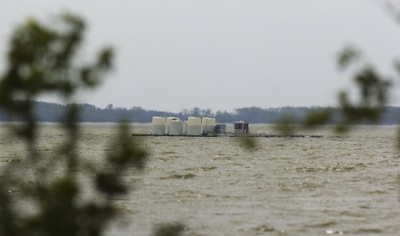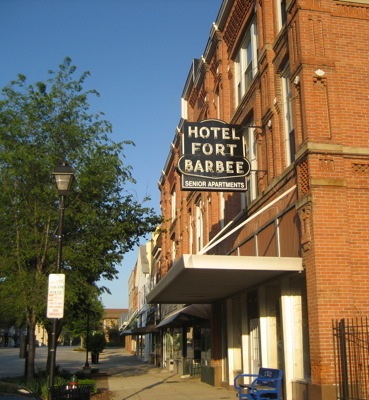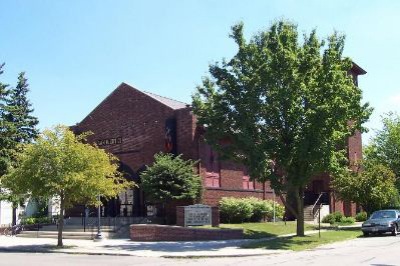Thursday, May 3rd, 2012
Lake gets only partial treatment
Company covers same section as last year with only slightly more alum
By Nancy Allen

Photo by Mark Pummell/The Daily Standard
A boat applies the final doses of alum to Grand Lake on Monday afternoon. The alum is hoped to deactivate phosphorous, blue-green algae's main food source. Official results are expected in September.
GRAND LAKE - The $5 million alum treatment on Grand Lake that ended Monday wasn't a whole lake treatment as state officials had touted.
Bethany McCorkle, ODNR spokeswoman, said just the 4,936-acre center of the lake got alum, the same area as last year.
"I think it was bad communication or bad information delivered to us communicators getting the information out," McCorkle said when asked why the state called it a whole lake treatment. "Internally, the state didn't get it correct and get the information out."
McCorkle said even though the entire 13,500-acre lake wasn't treated, this year's "more concentrated dosage" should produce a "lakewide effect."
The dosage concentration was 1 percent greater than last year's.
The treatment, which is used to help stave off toxic blue-green algae blooms, began April 2.
John Holz of HAB Aquatic Solutions, the subcontractor hired by the state to apply the alum, said the barges in 2011 applied 1.75 million gallons of alum and 877,000 gallons of sodium aluminate, a buffer that keeps Ph levels from fluctuating so fish are not harmed. This year, just more than 1.8 million gallons of alum and 904,000 gallons of sodium aluminate were applied. Holz spoke about the alum application during a breakfast meeting in Celina this morning.
The increase in cost - $3.4 million in 2011 to $5 million this year - was due to a 20-30 percent increase in chemical costs and fuel costs, Holz said.
The state also had the expense of hiring a general contractor this year, McCorkle said.
Milt Miller, manager of the local Lake Restoration Commission, said he was surprised to learn in January only the lake's center would be treated, but he believes the scientific explanation that treating only the center will give a lakewide effect.
"Throughout the entire endeavor we have trusted the science and what the science tells us is the most concentrated area of phosphorous is in the center and the alum disburses with wave action and wind throughout the lake, so you get that whole lake affect," Miller said. "It is a heavier dosage than last year's, so we have to trust that stronger dosage will give a whole lake benefit."
Brian Miller, manager at Grand Lake St. Marys State Park, agreed.
"Regardless of where we did it, it's tying up phosphorous and through the (sediment) core samplings it's been found that the heavier phosphorous load is in the center of the lake," he said.
Alum deactivates phosphorous, the main food source of the lake's toxic blue-green algae.
Prior to the lake's first alum treatment in 2011, the state conceded it did not have the funds to optimally treat the lake. Officials said they would aim to fund lower doses over consecutive years.
Holz said the lake has received 25 percent of the alum it needs to receive optimal treatment.
"You would need 75 percent more alum to treat the rest of the internal phosphorous already in the lake," he said. "That does not account for the phosphorous that keeps coming in."
Brian Miller said other activities aimed at restoring the lake's water quality continue.
State officials on Monday began a second year of rough fish removal on the lake's southwest side, and all three dredges are working on the lake. The dredges are at the Sandy Beach area east of the Mercer County Sportsmen's Club, Anderson's channel at the sportsmen's club and the mouth of Coldwater Creek. Rough fish such as carp and shad contribute to poor water quality because they rile up sediment in the lake's bottom and they excrete phosphorous in their waste.
Most of the phosphorous that enters the lake runs off farmland, the largest land use in the 58,000-acre watershed. Phosphorous-fed toxic blue-green algae blooms have resulted in advisories and millions in lost tourism on the lake the last three years.
Local officials said they are hoping for an advisory-free lake this year and look forward to welcoming visitors back to the lake.
"We're extremely optimistic that we will have an open lake again, and we are actively inviting people back," Milt Miller said. "It (alum) worked last year, and based on last year's success, we anticipate no less of a succes than last year."
Last year's alum treatment June 2-30 reduced phosphorous levels by 56 percent it the lake's center and 20 to 30 percent in untreated areas. McCorkle said the state hopes for phosphorous reductions equal to or better than last year's treatment. A full report on the results should be available in September.
McCorkle on Wednesday said no discussion has been held between local and state officials about treating the lake with alum next year.




